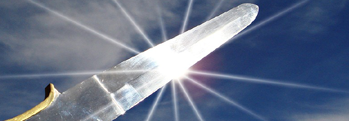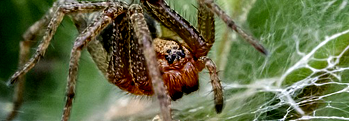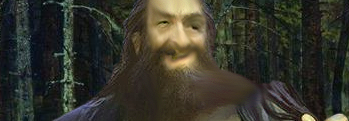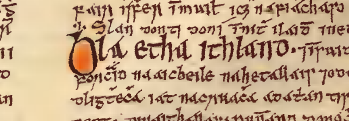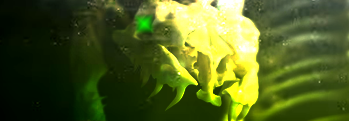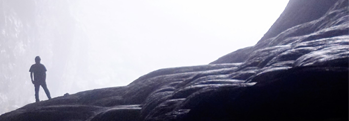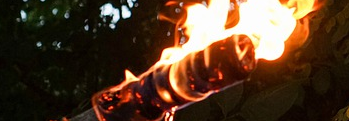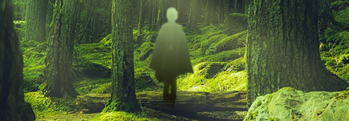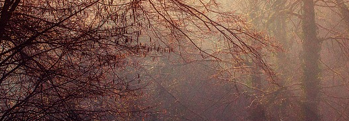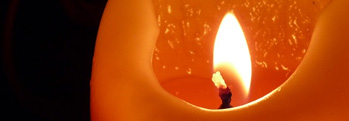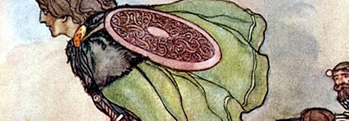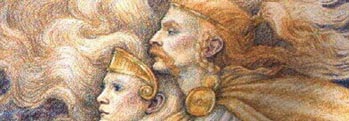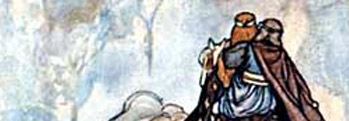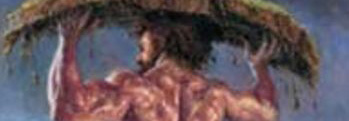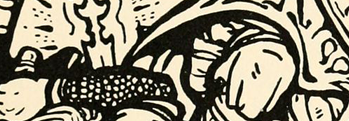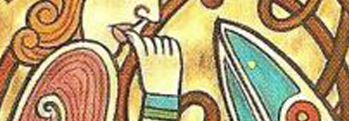Fionn and the Man in the Tree
Irish and Celtic myths and legends, Irish folklore and Irish fairy tales from the Fenian Cycle
Fionn and the Man in the Tree
 It is not unusual for stories in the Irish legendarium to have more than one meaning besides that of a literal recounting of historical events, whether by accident or by design. Some tales were meant to be understood in the context of the era and culture of the story teller, while others might instruct in certain arts, and yet others contain mysteries that couldn’t otherwise be committed to writing, knowable only to initiates.
It is not unusual for stories in the Irish legendarium to have more than one meaning besides that of a literal recounting of historical events, whether by accident or by design. Some tales were meant to be understood in the context of the era and culture of the story teller, while others might instruct in certain arts, and yet others contain mysteries that couldn’t otherwise be committed to writing, knowable only to initiates.
And to make matters more confusing, earlier stories were often stirred in by well-meaning storytellers to make them more memorable, so myths from many ages might be unknowingly told in the one telling!
Written in the law tract Senchas már, the otherwise strange and seemingly unfinished tale of Fionn and the Man in the Tree is just such a story. But perhaps it should be said, the story is indeed quite finished, if only you know how to read it! And so the legend goes...
One day, Fionn and his Fian were in a forested clearing on the bank of the Súir river, and was their habit to take the skinned and prepared animals they had hunted and put them in basins dug into the ground, along with water and hot stones for boiling.
It would take a few hours to cook this way, so they would sit around campfires and play games of fidcheall or some music while they waited.
But on this night,when they went to take their cooked food out of the boiling-pits, they were amazed, for there it was – gone! Someone had lifted their food and the men would go hungry that night. Fionn looked high and low in fury for the culprit but could find nothing, and they resigned themselves to a meal of such nuts and greenery as they had handy.
Then the next night, the same thing happened despite their posting guards, and again, the night after that! Fionn’s anger grew hotter each time until he decided on a plan – he would secrete himself into one of the pits and only breathe through a straw under the water, while just enough hot stones were dropped in to keep the trough warm.
Sure enough, before too long he felt hands lifting him up as though he were nothing but a child, although he was by this time a full-grown man, and he felt himself being carried towards a nearby fairy-knoll on the plain of Femen in the darkness. He saw a light start to shine before him as the síd opened wide, and he struck down quickly with his hand, grabbing the wrist that held him aloft!
He heard a shriek and someone leaped into the open fairy-mound, past a woman who waited there with a smile on her face and a dripping bowl of wine in her hand. Well I can tell you, the smile fell off her face in a hurry when she saw Fionn bounding towards her!
Quick as you might wink, she kicked the heavy stone door shut, and it moved as though it was made only of light wood on greased hinges, but before it could shut entirely, Fionn grabbed the vessel, spilling wine on his hand, and squeezed his thumb between the door and the post.
The door slammed hard and he yelped in pain, withdrawing his hand quickly, and the door slammed again a final time. He put the thumb into his mouth and he began to chant some strange spell, unknown even to himself, then the imbas forosnaí or power of illuminating knowledge came upon him, and he could see the truth of all things.
Now of course, this wisdom would prove a very valuable asset in matters of the law and judgement, which is why we can find it written in a law tract of old Ireland! But perhaps the meaning here is to taste of the wisdom of times past and to let that inform the judge before judgement is passed.
Far stranger is the next part of the story, which speaks of Fionn and his men carrying off captive women from Dún Iascaigoc in the land of the Dési, and in particular one beautiful young maiden that captured Fionn’s heart as he had captured her person.
But she had other ideas, and tried to have her way with a serving lad who was with the Fian, even Derg Corra son of Ua Daigre. So apparently for a captured hostage she apparently had a fair bit of freedom in her doings and comings and goings!
She had seen this young man leap across the cooking fires without fear, his red hair reflecting the flames and the sunsets as one, and it was for this that she loved him. One day she came to him and said he should lie with her, but he was loyal to Fionn, but as they say hell hath no fury like a woman scorned – even if the rejection had little to do with her – and she went to Fionn and claimed Derg had made advances upon her.
She told Fionn to kill this poor lad, but Fionn said to him instead, “Get out of my sight, and you’ll have three days and nights to get as clear as you can. After that, beware should our paths cross again!”
So Derg Corra fled to the deepest parts of the forest, and used to go about on shanks of deer for his lightness. But one day after that, Fionn was looking through the forest on a hunt, when he saw a man in the top of a tree, a blackbird on his right shoulder and in his left hand a white vessel of bronze, filled with water.
In the bowl was a skittish trout, and there was a stag at the foot of the tree. And this was the gesture of the man, to be cracking nuts – he would give half the kernel of a nut to the blackbird that was on his right shoulder while he would himself eat the other half; and he would take an apple out of the bronze vessel that was in his left hand, twist it in two, throw one half to the stag that was at the foot of the tree, and then eat the other half himself.
And on it he would drink a sip of the water in the bronze vessel that was in his hand, so that he and the trout and the stag and the blackbird drank together.
Then his followers asked of Fionn who he in the tree was, for they did not recognise him on account of the hood of disguise which he wore. So Fionn put his thumb into his mouth. When he took it out again, his imbas illuminated him and he chanted an incantation:
"Along with drinking in common with a salmon, Dercc Corra of the desert eats jointly with a blackbird half of a nut that he has cracked. It was not with a bending movement of it that the son of Ó Daigre split his wine-sweet apple against a sharp set of teeth".
Then saying “'Tis Derg Corra son of Ua Daigre and none other that is in the tree!”
And there the story ends. But what does it mean? There are as many interpretations as there are readers, but some believe it speaks of the nearness of the old people of Ireland to nature, and that it is possible to live in harmony with the wild.
Others say the man in the tree represents the universe as seen by Christian if not pagan, with the otherworlds above and below, identifying the blackbird with the aerial planes of the cosmos, the stag with the earthly, and the fish with the subterranean and aquatic.
It may have had a simpler meaning, with the different animals representing parts of the law, remembering this was found in a book of law, and the different foods, standing in for justice, charity and other leavens.
The lad’s name is also worth contemplating, as some authorities have made it clear they don’t think it means “red” and instead propose dercc, with one of three meanings – eye, hollow or cavity, pool, or berry. Corr is also similar to other words, these being peak or point, crane, or heron – a marvellously mystical bird in Irish mythology – and pool, well or depression.
As such, the story could be read to mean the fugitive had transformed a great tree into a sacred, liminal space, within which it was forbidden to do violence, after the manner of the mighty clan trees, the bile, at the heart of each Irish clan in times gone by. In a tome of laws, this would remind judges and petitioners of the divisions between the rights of man and those of things considered divine, and the firm line between them.
In the end we have no clear idea what the story means, what the animals represent, or how it all comes together, but sure isn’t thinking and learning about it half the fun!
Senachas Már was written near the location marked on the map below!
More Legends from the Fenian Cycle
The days of the heroes of the Fianna have captured the imaginations of many throughout the ages, and one such was the ninth century poet Gofraidh Fionn O’Dalaigh, one of the finest poets in all of Killarney and all of Ireland. For it was his pen and none other that first put quill and ink to parchment and recorded the old story of Reicne F ... [more]
It was a fine day in Ireland many years ago when Fionn and his Fianna took a fancy to go out hunting. Warm was the sun amid the whispering glades of ancient forests, gentle was the breeze and sweet the scent of summer flowers in its bosom. Sweeter yet was the sight of a mighty deer to the eyes of the hunters, and so they gave chase, howling with de ... [more]
It was in the days of Fionn and the Fianna, a very long time ago in Ireland, that the people of Ben Edair decided to hold a festival, a Feis or Aonach, to celebrate the season. All of Fionn’s hosts were gathered, the seven ordinary warbands and the seven extraordinary warbands, and they danced and played music merrily with the people. Then ... [more]
There are few these days who have not heard of Fionn Mac Cumhaill, hero and defender of Ireland, or at least might recognise his name. But there were no creatures that Fionn loved amongst his three hundred dogs more than his two favourites, Bran and Sceolan, meaning Raven and Survivor, and though it’s a stranger story than most, this is the t ... [more]
It is not unusual for stories in the Irish legendarium to have more than one meaning besides that of a literal recounting of historical events, whether by accident or by design. Some tales were meant to be understood in the context of the era and culture of the story teller, while others might instruct in certain arts, and yet others contain myster ... [more]
Those monks who recorded the mythologies and folklore of Ireland which had previously been passed down by word of mouth from bard to druid to bard for countless generations were, by their very nature, devout Christians. As Christians they were dedicated to not only God and His Church, but to the people who bore and nurtured them, and everywhere the ... [more]
One day Fionn Mac Cumhaill, doughty hero of Ireland, and his friends Goll, Cialta and Oscar, as well as others of the Fianna, were resting after the hunt on a certain long hill now known by a different name. Their meal was being made ready, when what should happen only a girl of the kin of the giants came striding up and sat down among them, a grea ... [more]
Something which often appears in the most ancient tales of Ireland is the grisly vision of heads which speak after being separated from their bodies! This was said to be an art of the druids inherited from the necromancy of the Dé Danann, who were themselves said to be able to raise a whole army from the grave to fight again day after day! ... [more]
There once was a young fellow called Conall, and he lived with his parents in the east of the country. They lived a quiet life, catching fish and digging up oysters for meat and lamps, but one dark day the Fomors came and demanded tribute. Having none to give, his father bid the sea demons begone, but instead they made to take himself and his famil ... [more]
Young Fionn Mac Cumhaill was out walking with his dog Bran one fine morning, and he happened to pass into a deep and thick dark wood of the kind that once covered all of Ireland, for the hunting was better there, when what did he come across but a thousand horses hauling timber and men chopping down the trees and preparing the logs. "What a ... [more]
There was a mighty warrior in the west of Eriu, and Cumhal Mac Art was his name. Feared was his axe and he could skewer two men with a single cast of his feathered war-dart, and yet for all that he lived a lonely life, and a life of fear – for it had been foretold that should he ever marry, he would die in battle the very next day! But all ... [more]
It was in the day of Fionn Mac Cumhaill when he was an old man, yet still hale and hearty, that one of his warriors, whose name was Diarmaid son of Donn and grandson of Duibne, had carried off his young bride-to-be, Gráinne daughter of Cormac! The two had fallen in love and Gráinne, for all of Fionn's fame, wanted nothing to do wi ... [more]
One warm summer's day Fionn and his men were out hunting through the darkling forests of Ballachgowan in Munster, chasing deer and boar through the gloomy glades, when they stopped short all of a sudden and came face to face with a startling sight! For what had stepped between them and their prey but a strange, damp giant of a man. Black wer ... [more]
Fionn Mac Cumhaill stood at the door of his hunting lodge with his fists on his hips, his heart sinking as he realised his intentions to hunt for deer this day were lost in the waves of mist and fog that had rolled in from Dublin bay, although at that time it was known by a different name. It had come as far inland as Gleann na Smol, the Glen of th ... [more]
When Fionn Mac Cumhaill became leader of the Fianna, the fiercest and most warlike of those bands of heroes who lived in the wild places, hunting and acting as champions for their kings, and defending Ireland from evil, he decided that he wished to have only the best warriors to follow him. So he sat down and sucked his thumb to taste the wisdom ... [more]
Close by where Limerick city stands today lie the ruins of an ancient and once mighty fortress called Carrigogunnel, which commanded all the lands about with a stern hand. It was known then as a place of ill omen, and it is known today as the same, for it was once the home of an uncanny hag by the name of Gráinne. Amid the surrounding mar ... [more]
A dark horde of fell-handed warriors approached Ireland, sails gathered off the coast like storm clouds, billowing out in the gusts of uncertain wind, while oars bent to the rolling thunder of drums. Fierce indeed was the host of King Colgan, master of Lochlainn, and he came to make war on Cormac Mac Airt, High King of Ireland! As soon as Fionn ... [more]
Diarmuid the Fair, son of Donn or Duibhne of the Tuatha De Danann was one of the Fianna, the great warriors of ancient Ireland who protected the land from dangers near and far. It was said that no woman could resist his gaze, for he'd been granted the blessing of comeliness by the Ghost Queen Morrigan after he helped her out of a spot of bother ... [more]
Fionn Mac Cumhaill and the rest of the Fianna were resting after a great battle, weary and sore with sorrow at the loss of their fellows, when they spied coming along the shores of Loch Lein in County Kerry a beautiful young woman riding a swift horse, so swift indeed that its hooves scarcely seemed to touch the ground! Now although the women of ... [more]
Now it is known by some that the fairies of Ireland weren't much like the fairies we hear about in these latter days, harmless things of mischief and frolic, but were instead respected and often feared, for their anger was quick and their kindness was whimsical. Some would join men in battle, and some would make war on men, others were omens of ... [more]
It was a fine brisk spring morning in Ireland when Fionn Mac Cumhaill decided to take himself for a stroll along the white sandy beaches of the seashore, the better to breathe the air and enjoy the simple pleasures life had to offer. But that morning, life had more to offer and it didn't look pleasant, for it was a giant bearing down on the bea ... [more]
Fionn MacCumhaill was well known as a fair and handsome man, but his most distinguishing feature was his grey hair - and he was not born with it! Fionn was one time out on the green of Almhuin, and he saw what had the appearance of a grey fawn running across the plain. He called and whistled to his hounds then, but neither hound nor man heard hi ... [more]
After his seven years of training with the poet Finegas were done, Fionn Mac Cumhaill took himself from the river Boyne to the great hall of the High King in Tara, Conn of the Hundred Battles, to present himself there as a member of the Fianna, the very best of the best warriors throughout Ireland. Announcing himself, Conn took him into the band an ... [more]
Here is the story of how Fionn MacCumhaill gained the knowledge of the world. And wouldn't it be a great thing to know it all? Still, knowledge and wisdom must be balanced, and this was known to the young man called Fionn, which means fair and bright. He was fleeing from the warriors who had murdered his father when he came upon the hiding plac ... [more]




